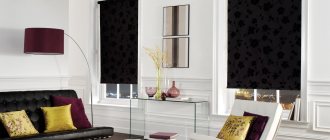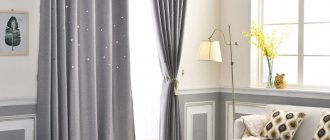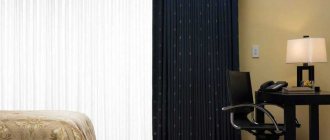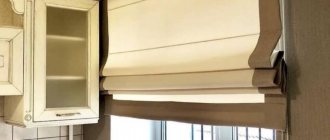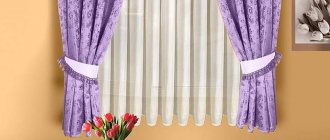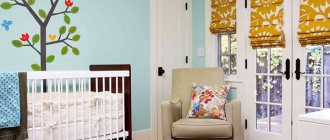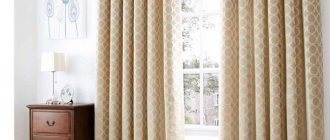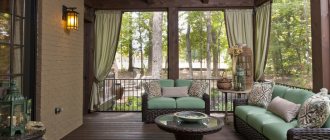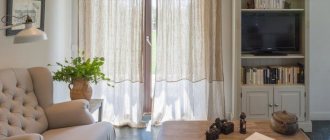Features of light transmission
What does light transmittance mean? This is the amount of light that a material can transmit. The higher the degree of light transmission, the more light there is in the room when the curtains are closed.
The light transmission of roller blinds depends on the density of the selected fabric. As a percentage, it can be 50%, 80%, 100%. Complete darkness is created by the densest blackout fabric. It will appeal to home theater lovers, as well as residents of regions where there are white nights.
The peculiarity of blackout material is that the outer side of the curtains reflects not only light, but also heat. In the summer, this provides good relief from the heat and the apartment does not heat up. In cold weather, when there is no heating, the fabric prevents heat from leaving the room. It is worth purchasing thick curtains with low light transmission in the following cases:
- The need to get enough sleep during the day due to night shifts;
- The location of the apartment is on the sunny side of the house;
- White Nights;
- The location of bright lanterns and other lighting fixtures near the window;
- The light falling from the window causes glare on your computer monitor or TV.
Ordinary standard models diffuse light and create slight darkness. This solution is suitable for interiors where good lighting plays an important role. Light-absorbing materials block up to 80% of light.
Light transmission of curtains: what does it mean as a percentage, how to choose curtains based on light transmission
Roller blinds (80 photos): types, ideas for interiors
In a small room for a teenager or student, you can profitably save space with the help of a new type of bunk bed: below is a desk, on top is a bed.
Types of fabrics that block light
There are several degrees of shading: complete (blackout) and partial (dimout). The first type of curtains is well known, but none of my clients suspected the second type.
In the photo: an example from our studio project
-
this is what blackout fabric looks like.
Even the outline of the window cannot be seen behind the curtain 1. Blackout: blocks out almost 100% of the light
Blackout is translated from English as “darkening.” It is believed that this type of fabric was invented in Finland, where it is generally impossible to sleep without thick curtains. The result was an illusion of the night.
The light transmittance of blackout curtains in percentage is almost zero: this is a fabric with a density of about 285 g/m2, which looks completely different “from the street” and in the interior. On one side it has a special white coating that reflects light - it should be facing the window. On the other hand, there is a decorative base that is responsible for beauty.
By the way:
Lightproof fabric for curtains can be used either independently or as part of a complex curtain - as a lining. The second scenario is used if a specific pattern is needed in the interior - for example, a companion fabric to wallpaper.
What problems are solved:
First of all, sleep problems. Many people who suffer from insomnia benefit from complete darkness. Suitable for northern latitudes. Handles directional beams and glare if you want to create a home theater atmosphere.
Minuses:
With such curtains it is easier to fall asleep, but more difficult to wake up. Complete darkness can be disorienting.
Bedroom for a girl in a modern style: design ideas in the photo
Misconception:
I had to deal with the stereotype that blackout fabrics are necessarily dark. Apparently, this impression comes from the name. Actually no: blackout curtains can be light.
2. Dimout: block about 80% of the light.
What problems do they solve:
Dim the background light - from an advertising screen or a lantern. Relevant for the dining room-living room, where in the evenings you want to create a comfortable atmosphere.
Minuses:
Dimout fabrics are often sold under the guise of more expensive blackout fabrics - beware of fakes. Determining what exactly is in front of you is quite simple: turn on the flashlight on your mobile and place a cloth on the lamp: the blackout will not let the light through, and the dimout will only dim it.
Misconception:
It is often written on the Internet that black thread inside the weave is a 100% sign of blackout fabric. Customers believe this, especially since salespeople in salons support the stereotype and even show sections where the thread is clearly visible. In fact, the black thread can be inside the dimout. Its presence does not guarantee absolute impenetrability.
3. Just thick curtains
What problems do they solve:
It is most convenient to use such curtains according to the situation, at a specific time of day. The reflection of the sun in the window of the house next door is blinding - they closed it, the sun went away - they opened it.
Minuses:
They do not provide full darkness.
The perception of the interior largely depends on lighting, so it is very important that it is organized correctly. Mirrors, glass doors and light-colored furniture will help increase the flow of natural light. As for artificial lighting, organize a multi-level system. A carefully thought-out lighting scenario is a characteristic feature
This is exactly the option that I recommend when you need a beautiful textile design, and not darkness, like in the cellar. Blackout and dimout can also be draped, but with regular thick fabric the folds are laid out more beautifully. The variety of colors and designs of conventional curtain fabrics is incomparably greater.
4. Roller blinds or blinds
What problems do they solve:
A situational option for the kitchen or office, where fiddling with long draperies is inconvenient. And traditional floor-length curtains are not suitable for all styles. There are designs that are attached directly to the glass and are almost invisible when raised.
Minuses:
Some customers find it too “clerical”. In addition, long traditional curtains have additional bonuses - they can slightly dampen street noise and protect from drafts. Roller blinds and blinds do not have such options.
Fact:
It would seem that translucent roller blinds and blinds are ideal for customers with dust allergies. Such interiors should have a minimum of textiles. But removing the linen for washing is not always easy (sometimes it is simply impossible to put it into the drum of the machine due to the lower weighting material). When cleaning, a vacuum cleaner can leave marks on the canvas.
A solution for allergy sufferers: an exotic but very fashionable alternative - shutters.
The photo shows another example of unexpected window decor: instead of curtains, the designers provided a projector screen
Combine!
Use several types of curtains and types of textiles at once to get different shading scenarios.
Curtains + tulle
The translucent fabric in this tandem gives a feeling of privacy - everyday life is less visible from the street. A thick curtain can be a blackout, a dimout, or just a beautiful fabric - depending on the room and the direction of the world.
Blackout + roller blind
Option for rooms where it is critical to regulate the balance of light and heat - for example, a bedroom with windows facing south or southeast. Blackout is here to protect from light and heat in the early morning, while the owners are still sleeping - the coating reflects not only light, but also heat. “Roll” - for a comfortable morning without scorching rays. The light transmission of roller blinds in this case should be average.
Two textile sheets + roller blind
The most progressive option: one of the curtains can be made completely blocking, the other can be made from dimout fabric or a regular curtain. When you need to get rid of overheating (for example, on a hot sunny day), lower the roller blind.
Fact:
It is believed that in this tandem the thick fabric should be “beautiful”, and the inner part should be “smart”. But the other way around is also possible. For example, plain curtains plus light fabric with a pattern, as in the project in the photo.
Double layer roller blinds
When choosing curtains, you must remember that window design is a necessary element of any interior. Curtains should be combined with other decorative items.
Yes, this also happens: the lower translucent layer is used to cut off aggressive rays, the upper blackout is used for sleeping.
Other characteristics of roller blinds
The characteristics of the curtains are indicated in the product description. You can view them before purchasing and choose the appropriate option. Not only light transmission should be taken into account when choosing, but also many other nuances.
Also pay attention to:
- Material. Most often, curtains are made from high-quality polyester, but options with the addition of natural threads are possible. Remember that synthetics in this case are the best option. It does not fade, holds its shape well and blocks light.
- Mounting method. Curtains can be attached with self-tapping screws or adhesive tape. If you are not sure that you will not want to change this option to classic curtains, purchase curtains with adhesive tape. After removal there will be no holes left.
- Impregnation and thickness of the canvas. These factors also affect light transmission. The degree of repulsion of dust and dirt also depends on the impregnation.
Don't forget about the external design. The color and pattern of the canvas should be in harmony with the wallpaper, but not merge with it. So, for a room in Provence style, you can choose delicate shades and floral prints.
When choosing, pay attention to the information indicated in the model description. All questions can also be asked to a consultant.
Manufacturers
Light-protective curtains are produced by domestic and foreign companies.
- Master (Russia) produces light-protective roller blinds from fabric canvas and blackout. Photo printing techniques are widely used. Lifting mechanisms made in Holland. The electric drive is equipped with a remote control.
- Velux (Denmark) specializes in the production of skylights and Siesta blackout curtains. Canvases can be used not only in attics, but also in ordinary bedrooms, living rooms or children's rooms. "Siesta" darkens the room 100%. The company's assortment includes 40 colors of this model. The light-proof curtain for the window is made of polyester. It is dirt resistant and easy to maintain. The aluminum coating on the back of the model provides good thermal protection. The simple design can be installed in a few minutes (Pick&Click system).
- Roto (Germany) produces RotoStandart roller blinds with an aluminum layer that reflects heat and light. The products are mounted on the frame without a gap, which enhances the light-protective properties of the models. The curtains rise smoothly and are fixed in three positions. The canvas is impregnated with a substance that provides resistance to light and ease of maintenance. RotoStandart is made from 3 materials, in 37 different colors.
- The Turkish company Apolena produces light-protective curtains for the living room and bedroom. The collection includes plain products and models with patterns of rich colors, made of 100% polyester.
Light-protective curtains calm you down and give you a long, sound sleep. They create a romantic atmosphere and prevent glare from TVs and monitors. This is the textile item that takes care of our well-being and comfort.
© 2021 textiletrend.ru
How to choose roller blinds?
There are many options for roller blinds. You can choose a solution for any window and interior style. It is recommended to make roller blinds to order so that they fit perfectly under the window opening.
To choose the right curtains, use the following recommendations:
- If you are undecided whether you want complete darkness or light partial shade, pay attention to a variety such as “Day-Night”. The fabric of such curtains consists of alternating strips of translucent and very dense fabric. Using the adjustment mechanism, you can move the strips, getting either complete or slight darkening.
- Synthetics are optimal for any room. The addition of natural fabrics reduces the moisture-repellent properties, so such curtains are hung in rooms with low humidity.
- For bedrooms, it is better to choose the most dense materials possible. Absolute darkness promotes the production of melatonin and makes sleep sounder and healthier. For the kitchen, on the contrary, translucent materials are more often chosen, which, when closed, let in enough light, but hide the room from prying eyes.
Selecting roller blinds based on light transmission
When purchasing, you need to determine in advance the degree of illumination and humidity of the room where you plan to install roller blinds, as well as its location and interior:
- If you need to choose curtains with high light transmittance, then you should pay attention to ordinary models; they diffuse light perfectly.
- If you want to get an eclipse effect with the transparency of the material itself, opt for light-absorbing curtains; they can block 80% of the sun's rays.
- If the room needs absolute darkness, then completely darkening (black-out) options are suitable.
What types of roller blinds are there?
Roller shutters on the market are made of bamboo, wood, textiles and PVC. The most popular models are those based on fabric carefully wound on a shaft. This way you can regulate the movement of the canvas to the required height and secure the structure at a certain distance.
There are open and closed roller blinds:
- Open. They include textiles and a shaft attached to the wall at the top of the window or to the window frame. To ensure that the curtain falls neatly, there is a strip at the bottom of the canvas.
- Closed. The shaft is located in a closed box, and additional guides run along the sides of the textile. The design allows you to completely cover the window with a curtain.
According to the degree of penetration of the sun's rays, curtains are:
- fabric, transparent;
- translucent;
- matte or with a darkening effect;
- day Night.
Based on the foregoing, it is clear that the secret of the popularity of roll structures lies in the quality of the material. Therefore, they are divided into ordinary ones, dim-out - light-absorbing by 80-90%, black-out - darkening by 90-100%.
Types of curtains that block light
There are the following types of light blocking curtains:
Let's look at them in more detail.
Blackout
The word “blackout” translated from English means “darkening.” This is what they call curtains that are 100% light-proof. It is believed that they were invented in Finland, since in part of the country there are white nights for 3–4 weeks a year.
From the street it is impossible to understand that the apartment has blackout curtains due to the light coating on the outside. And no light penetrates into the home.
They are able to reflect heat, so they protect from the summer heat. The opposite effect also works - blackouts maintain the temperature in the apartment during the cold season.
The entire product is sewn from light-proof fabric or used as a lining between layers of another material that looks more attractive.
Blackouts help you fall asleep in bright conditions (for example, during the day, during a white night). But it’s harder to wake up with them.
Dimout
Dimouts block at least 80% of the light. Suitable for protection from bright advertising banners and street lamps. Dimout is hung in the kitchen and living room.
Sometimes they try to sell such curtains under the guise of blackout curtains, which cost more. Therefore, you need to be careful when purchasing.
Blackout curtains
Such curtains are made of thick fabric, so they are cheaper than blackout or dimout. They are used according to the situation - on a sunny day they are covered, in low light conditions they are opened.
Plus - a large selection, thanks to which you can choose a curtain to suit any interior, the ability to sew it to order.
The downside is incomplete light protection. Dense fabric blocks no more than 40% - 50% of sunlight or light.
Roller blinds
Curtains made of thick material, collected in a roll located above the window. They transmit less light than dense ones. Not suitable for all interiors.
Blinds
They provide light protection at the dimout level, as they are made of dense polymer material. The downside is the “office” look, which is not suitable for living space.
Opaque curtains Blackout (total blackout)
Roller blinds are made from a special material that ensures complete opacity. In combination with a special system, a tight fit to the window is achieved, due to which the room will be completely darkened.
Roller blinds of this type perfectly reflect heat, so even in the heat of summer, the desired coolness will be maintained in the room. In winter, blackout curtains will maintain a comfortable temperature in an apartment or private house.
Using blackout curtains helps you fall asleep when it is light outside, but if they are closed, you can sleep for a very long time because the room will be dark.
Combinations
To reduce light transmission, curtains are combined. The following types of combinations are used.
- Thick curtains and tulle. Collectively thicker than one curtain. Retains 40% - 60% of light (depending on the material and density).
- Curtains and roller blinds. Provide protection from bright light in different conditions. Rolls provide almost complete darkness. Curtains let in more light, making them suitable for cloudy days.
- Blackout and roller blinds. Blackout is suitable for summer as it does not allow heat to pass through. Roller blinds - for other seasons or cool weather.
When to change the light transmittance of curtains
Light transmission is changed in the following cases:
- the TV or computer screen glows, glare appears, but there is nowhere to move the equipment;
- at dawn, the sun's rays penetrate the house or apartment, as the windows face east;
- near the house there is a street lamp, a bright advertising banner, and other light sources;
- the owner of the apartment lives in a region where white nights occur, making it difficult to fall asleep;
- I have to sleep during the day because I work the night shift.
When you don't need to change
The light transmission of curtains is not increased in the following situations.
- When you need light to enter the room. For example, due to interior features.
- If the main function of curtains is not to block the sun's rays, but to protect the room from the views of strangers.
- Due to the peculiarities of the pattern of the curtains. Some patterns only reveal themselves when the sun's rays shine through.
- In low light conditions. If the apartment is located on the ground floor or near trees, light has difficulty penetrating there. In this case, the curtains should have more light transmittance.
The permeability of curtains determines how much light the curtain lets in. It is increased when complete darkness or protection from sunlight is needed (for example, if the TV screen or computer display is reflective). Based on light transmission, curtains are divided into blackout, dimout, and thick. The first do not transmit light at all. The latter retain 40% - 50%.
Textiles for making roller blinds
For the production of roller blinds, 9 main types of materials are used:
- Polyester. Practical material, perfectly reflects and absorbs sunlight, has antistatic and dust-repellent qualities.
- Adding viscose allows you to get a fabric with an interesting structure.
- The material with the addition of cotton is distinguished by its durability and good shrinkage. But it is not recommended to use the canvas in rooms with high humidity (bath, kitchen), otherwise the material may become deformed.
- As a result of the unusual combination of polyester and satin, the fabric has an attractive shine, but the material may shrink slightly with use.
- Adding acrylic. A thin layer of acrylic coating gives the material softness and helps maintain its shape.
- Fiberglass with polyvinyl chloride. It is durable and resistant to high temperatures, which allows the fabric to be used even in saunas.
- Linen with cotton. The combination looks very interesting, perfect for houses with a rustic flavor.
- Opaque textiles. Fibers made from a special material do not allow sunlight to pass through. But with sudden temperature changes, the side edges of the fabric may bend.
- Scorched fabrics. Acids are used when processing the material. This allows you to get a high-quality and beautiful canvas. The most effective and expensive option.
Advantages of blackout curtains
- Protection from any light from the street up to 100%;
- High wear resistance and resistance to fading;
- Hypoallergenic and non-toxic;
- Heat and sound insulation: curtains absorb noise well, keep the room cool on hot days, and warm on rainy days;
- Fire resistance;
- Practicality in care and use (do not wrinkle, drape well and keep their shape, easy to clean, repel dust);
- Large selection of colors, prints and formats to suit any interior.
Multi-colored combined blackout curtains in a spacious living room
Light-diffusing and reflective fabric: what's the difference?
Curtain materials with low light transmittance are divided into two types:
The principle of operation of these materials is fundamentally different, and they are used in different conditions. Let's look at how these types of curtains work and which one should be purchased in which situation.
Light-diffusing fabric
Light-diffusing textiles are widely used in the manufacture of advertising signs. It is called backlit. This is due to the design features of the fabric - literally backlit means “lined at the back”. The material has a special polymer coating located on its back side.
The principle of operation of the material is light scattering. In practice, this means that the curtain does not block it completely. But thanks to the layer made of polymer, it dissipates it as much as possible and breaks it down. Thanks to this, light practically does not penetrate into the room.
